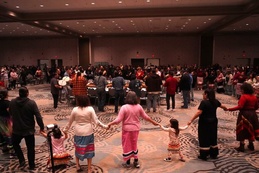The Biomistake
April 25, 2010
The Biomistake: slanted survey & bad research are behind a bad ideaAnd so it has come to pass that Traverse City Light & Power (TCLP) has
decided to build a biomass plant and burn our forests to produce
electricity.
We’ve been assured their tree harvesting will focus on just the crummy
trees and these efforts will thin the forests and make them healthier than
ever. This process is sustainable because, well, there are trees all over
the place up here. It’s renewable because crummy trees keep springing up
that deserve to be harvested; their crumminess a blight on the more
upstanding trees. We weren’t even aware our woodlands were unhealthy.
It’s a pretty good bet they aren’t suffering from a lack of human
intervention but maybe they needed a date with chainsaws and
wood-chippers, a kind of botanical species cleansing. They’ll use some of
the detritus from the forest floor, too.
Many of us thought nature was the best steward of its own forests. We
learned in junior high that all those less desirable trees and that forest
floor “trash” served a purpose. The trees are home to birds and bugs.
The stuff on the forest floor that crunches beneath our feet decays,
microbes go to work, the trash becomes compost which becomes home to any
number of little crawly multi-legged critters which become food for
slightly bigger critters and that compost also grows all kinds of
interesting little plants and wildflowers and baby trees. What do we
know?
This new biomass plant, so we’re told, will burn at such high temperatures
there will be hardly an pollutants fouling the neighbors‘ cars and homes
and our air. The big trucks off-loading the chips will be kind of
annoying, but nothing we should fret about. The neighbors in the area are
somewhat less sanguine about the prospects of a big furnace nearby, but
sacrifices must be made.
Since this is a project that will take years to plan and build, why not
dedicate the time to solar or wind power? Too expensive, we’re told, and
the technology just isn’t there, yet. Plus, it’s hard for a utility
company to monopolize wind or the sun. Oil is out of the question as is
natural gas though this country has it in great abundance. “Clean” coal?
Hey, I like a good oxymoron as much as the next person but that’s just
silly. We’re still afraid of nuclear power and those pesky spent fuel
rods that are deadly for 200,000 years.
So, according to TCLP, the only real alternative to reach their goal is
biomass. It isn’t the only alternative, but more about that later.
TCLP even says this project has significant public support. They have
“research” to back them up, claiming their customers favor this biomass
option by a 2 to 1 margin. Why, it’s democracy in action and they’re just
here to do the will of the people they serve.
The survey, in its entirety, is located on their website
(http://www.tclp.org/”www.tclp.org) and it’s worth a look. It’s a pretty
good example of how to conduct a survey and get exactly the response you
want. There are a series of questions about cost, reliability, local
jobs, purchasing local products and environmental sensitivity.
Shockingly, TCLP customers like cheap, reliable electricity, support local
jobs, want to buy locally and favor environmental sensitivity. Those
questions are the set-up. Then comes the pay-off, and pay close attention
to the wording here:
“Traverse City Light & Power is currently investing in wind, solar, and
landfill gas electric power generation. To further diversify, Light &
Power is considering building a local renewable power plant that uses wood
chips, commonly known as biomass, for fuel. This plant would be
relatively small in size, fully enclosed, and located in an industrial
area. The plant’s emissions would be less than coal, would meet Federal
and State standards and would likely increase truck traffic in the
immediate vicinity. An independent evaluation of the impact on Traverse
City Light & Power customers determined that biomass is lower cost than
other energy sources, including wind, solar, coal and natural gas.
How would you rate your level of support for this initiative?”
Oh, my. Not a word about cutting down trees or sustainability or air
quality. Even the final question presumes a level of support rather than
asking if there is any support. This is a very close cousin to what, in
politics, is known as a ‘push‘ question. The respondent has been pushed
to answer in a certain way.
Even then, TCLP couldn’t generate more than 53% support, frighteningly low
given the nature of the question. They’ve even incorrectly weighted the
results in order to push their meager support up a couple of additional
points. If there was going to be an election on this issue and their
opponents had a chance to tell their side, TCLP would be headed for a
serious thumping.
Meanwhile, there is an alternative TCLP gave up on, can no longer control
and, therefore, ignores. The Boardman River has already existing
hydroelectric dams. They need updating and retrofitting but the
infrastructure is already in place. There are people who claim they can
make these things produce electricity again. It would be completely clean
absent any pollutants at all. The Boardman’s fisheries and riparian
habitats would remain unchanged.
Yes, it will be nice when we can remove the dams (except the one that
serves as a lamprey eel barricade) and let the river run free. But, in
the meantime, why are we ignoring an obvious resource and, instead,
hacking away at our forests and burning them to provide electricity?
Because TCLP gave away the dams but has access to our trees. And the
whine of a chainsaw is more attractive to them than the rush of water as
long as it generates the jangle of money in their cash registers.
The Trouble with Bad Research:
Traverse City Light & Power is justifying their decision to move forward
with a biomass program, at least to some extent, on the basis of research
conducted by the Research Services Department at Northwestern Michigan
College.
In 30 years of working in politics and on political campaigns, I’ve had
the opportunity to be involved in a dozens and dozens of research
instruments. I’ve helped write some that were intended to give us a true,
unbiased sense of where voters stood on issues or candidates. And I
helped write some that were intended to push voters to a certain position
on candidates or issues. It is clear the TCLP research was closer to the
latter effort than the former.
Unbiased research requires incredible care in the order of the questions
and the language used to avoid any bias. The language used in the TCLP
research, especially on the key question of support, is obviously biased.
It’s hard to imagine this being done accidentally given the overwhelming
nature of the bias. There is a reference to “wood chips” but no reference
to the fact that trees will have to be harvested to acquire those wood
chips. Respondents are told the plant will be small, enclosed, located in
an industrial area, meet pollution standards and be cheaper than other
sources of energy. Some of those assertions are matters of opinion and
open to debate but absent any contrary language they stand as factual and
naturally move the respondent to a position of support. Unbiased research
would include arguments made by opponents including sustainability,
deforestation, pollution, noise and neighborhood intrusion. That language
can be used in the same statement or in a following statement after which
the support/unsupport question can be asked.
According to the researchers with whom I spoke, there are also serious
flaws in the way the numbers are weighted. According to TCLP’s own data,
residential customers make up 83% of their combined customer universe,
commercial customers make up 17% and primary customers .003%. But in the
research document, residential customers make up only 58% of the
respondents, commercial customers are up to 41% and primary customers 3%.
Since residential customers are the least supportive and commercial and
primary customers the most, the reduction of residential customers and
inflation of commercial and primary user numbers skew support upward. It
distorts the results sufficiently to cast doubt on the efficacy and
scientific rigor used.
Finally, only TCLP customers were surveyed. They have a vested interest
in cost issues. But any potential negative impacts of the plant, like
pollution or deforestation, affect all local residents, whether they are
TCLP customers or not. It is impossible to know if surveying the broader
universe would have significantly changed the results.
With the combination of biased language, inaccurate weighting and
respondents with a predisposition to favor cost issues, the research
becomes more of a public relations instrument than a useful research tool.
That is further evidenced by the fact that the contact people listed are
from marketing departments and not the actual researchers.
TCLP and NMC are certainly entitled to conduct research as they see fit.
But since one is publicly owned and the other publicly financed, it is
troubling that they use flawed research in an effort to convince us a
highly controversial biomass plant has widespread public support when that
may not be the case at all.
Stephen Tuttle is a political consultant who formerly wrote for the
Arizona Republic.
Trending

Our Top Stories of 2025
Each year, we look back at the stories we’ve shared over the last 12 months and pull together the ones that got the mo… Read More >>
A Solo Rattler
Frontman of folk-rock band Michigan Rattlers Graham Young brings his solo performance to Great Lakes Center for the Arts in … Read More >>
GTB Starting the Year with Tradition
The Grand Traverse Band of Ottawa and Chippewa Indians hosts the Kchi Wiikwedong Anishinaabek Maawnjidowin Round Dance on Ja… Read More >>


